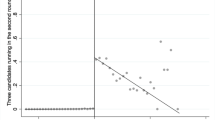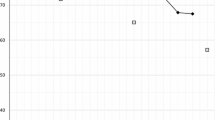Abstract
This paper uses a new data set of 885 California ballot propositions from 1912 through 1990 to test the hypothesis that voter turnout increases as an election becomes closer. Various measures of voter participation are regressed on various measures of election closeness. The main finding is that there is not a systematic relation between closeness and turnout. Two conclusions are drawn: (1) voters are not sensitive to the probability their votes are decisive, and (2) other studies which found higher turnout for close elections probably detected an increased mobilization of party elites in tight races.
Similar content being viewed by others
References
Barzel, Y. and Silberberg, E. (1973). Is the act of voting rational?Public Choice 16: 51–58.
Chapman, R.G. and Palda, K. (1983). Electoral turnout in rational voting and consumption perspectives.Journal of Consumer Research 9: 337–346.
Cox, G.W. (1988). Closeness and turnout: A methodological note.The Journal of Politics 50: 768–775.
Cox, G.W. and Munger, M.C. (1989). Closeness, expenditures, and turnout in the 1982 U.S. House elections.American Political Science Review 83: 217–231.
Crouch, W.W. (1950).The initiative and the referendum in California. Los Angeles, CA: The Haynes Foundation.
Crain, W.M. and Deaton, T.H. (1977). A note on political participation as consumption behavior.Public Choice 32: 131–135.
Crain, W.M., Leavens, D.R. and Abbot, L. (1987). Voting and not voting at the same time.Public Choice 53: 221–229.
Denver, D.T. and Hands, H.T.G. (1974). Marginality and turnout in British general elections.British Journal of Political Science 4: 17–35.
Downs, A. (1957).An economic theory of democracy. New York, NY: Harper & Row.
Durden, G. and Gaynor, P. (1987). The rational behavior theory of voting participation: Evidence for the 1970 and 1982 elections.Public Choice 53: 231–242.
Filer, J.E. and Kenny, L.W. (1980). Voter turnout and the benefits of voting.Public Choice 35: 575–585.
Foster, C.B. (1984). The performance of rational voter models in recent presidential elections.American Political Science Review 78: 678–690.
Glazer, A. and Grofman, B. (forthcoming, 1992). A positive relation between turnout and plurality does not refute the rational voter model.Quality and Quantity.
Hansen, S., Palfrey, T.R. and Rosenthal, H. (1987). The Downsian model of electoral participation: Formal theory and empirical analysis of the constituency size effect.Public Choice 52: 15–33.
Kau, J.B. and Rubin, P.H. (1976). The Electoral College and the rational vote.Public Choice 27: 101–107.
Key, V.O. and Crouch, W.W. (1939).The initiative and the referendum in California. Berkeley: University of California Press.
Matsusaka, J.G. (forthcoming, 1992). Economics of direct legislation. The Quarterly Journal of Economics.
Matsusaka, J.G. (May 1991). A psycho-economic theory of voter turnout with an application to declining U.S. voter participation. The University of Chicago.
Matsusaka, J.G. and Palda, F. (1991). The Downsian voter meets the ecological fallacy. University of Southern California and the Fraser Institute.
Riker, W.H. and Ordeshook, P.C. (1968). A theory of the calculus of voting.American Political Science Review 62: 25–42.
Rosenthal, H. and Sen, S. (1973). Electoral participation in the French Fifth Republic.American Political Science Review 67: 29–54.
Silberman, J. and Durden, G. (1975). The rational behavior theory of voter participation: The evidence from congressional congressional elections.Public Choice 23: 101–108.
State of California. (1912–1990).Statement of vote. Sacramento, CA: Office of the Secretary of State.
Author information
Authors and Affiliations
Additional information
I received helpful comments from Filip Palda, Ian Parry, Jeffrey Smith, members of the Economics Summer Workshop at The University of Chicago, and an anonymous referee. I am grateful to the Bradley Foundation and Olin Foundation (through grants to the Center for the Study of the Economy and the State) and The University of Chicago for financial support.
Rights and permissions
About this article
Cite this article
Matsusaka, J.G. Election closeness and voter turnout: Evidence from California ballot propositions. Public Choice 76, 313–334 (1993). https://doi.org/10.1007/BF01053302
Accepted:
Issue Date:
DOI: https://doi.org/10.1007/BF01053302




